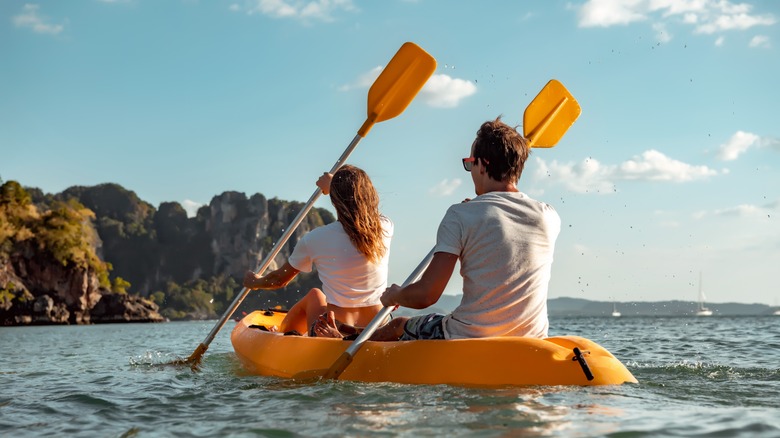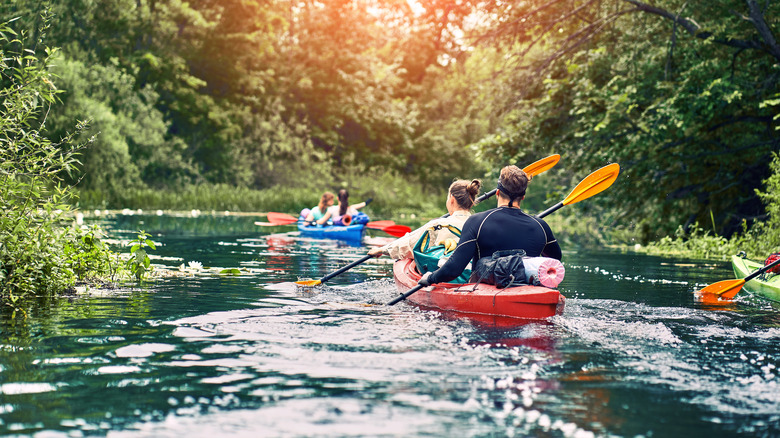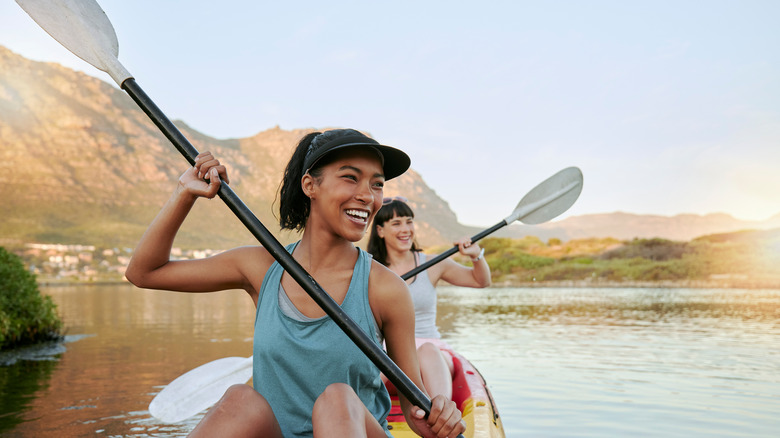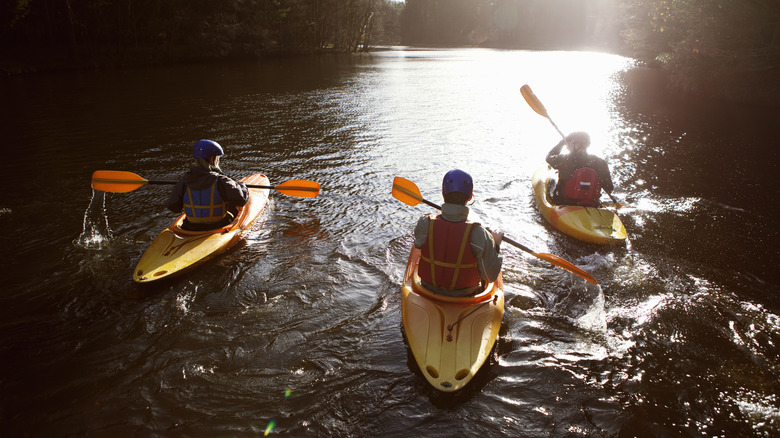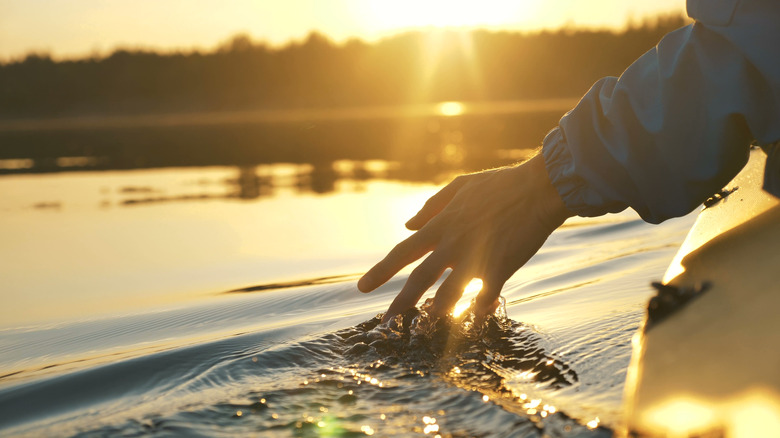5 Big Mistakes People Make When Kayaking
Whether you own a kayak or rent one for the day, taking a boat out onto your local waterways is a great way to explore nature while also relaxing and enjoying the warm sunshine. The only problem with kayaking is that it is more difficult than it looks and it is easy for beginners to make a few mistakes that can impact the quality of their experience. These mistakes can range from harmless issues like paddling incorrectly, to more serious problems like ruining your phone or even risking your life.
In fact, according to data from the US Coast Guard, kayaks caused the second-highest number of deaths and drownings in 2021 when compared to other personal watercraft like motorboats and pontoon boats. One easy way to prevent this is to make sure to always wear your lifejacket while on the water in case of unexpected wind, storms, or currents and also to remain sober during the entire experience. Once you have checked these two safety measures off the list, there are a few other less severe mistakes you'll want to avoid in order to make sure you have a great day out on the water.
Holding and using the paddle incorrectly
One of the most common mistakes among beginner kayakers is holding the paddle incorrectly. Specifically, most new kayakers tend to flip the paddle over and hold it upside down. This not only looks silly but also makes paddling more difficult and less effective. If you are holding your kayak paddle correctly, you should see that the top edge of the paddle is longer than the bottom edge. When looking at the paddle from above, you should also see that the paddle is slightly curved to make a small scoop. The scoop of the paddle should be facing you so that when you pull against the water, the paddle grabs the water and pushes it backward propelling you and your boat forward.
Once your paddles are facing the right way, you should look at how you are paddling. Many people just getting started with kayaking assume that paddling is all about arm strength. However, paddling using only your arms is incorrect form and will tire you out very quickly. Instead, most of the power behind paddling should come from your torso. To make sure you are doing this, every time you push the paddle forward to dip it in the water, you should be twisting your torso instead of moving your arms. This method allows you to use the strength of your entire upper body and core to paddle and is much more efficient.
Not putting all valuables inside a waterproof bag
While you may be certain that you aren't going to get wet or flip during your kayaking experience, it is still best to put all of your valuables (like your phone, car keys, and wallet) into a waterproof bag that is attached to your life jacket or boat. No one goes out onto the water planning to flip their boat, but it happens all the time anyway due to unforeseen circumstances. You can even accidentally capsize yourself by digging your paddle too deep in the water when trying to make a strong maneuvering stroke or when trying to splash another kayaker.
Even if you have a waterproof phone, it is important to store it safely in a bag that is attached to your or your boat. This is because when you flip, everything in the boat will float out into the water. It doesn't matter how waterproof your phone and car keys are if they are hanging out on the bottom of the lake and you can't reach them.
Not bringing enough food, water, and sunscreen
Because floating out on a crystal clear lake looks so leisurely and relaxing, many people forget that kayaking can be a strenuous full-body workout. Because of this, just as if you were going on a long hike, you will need to bring plenty of water, food, and sunscreen for your kayaking journey. It's easy to forget to stay hydrated while kayaking because you are likely thinking about other things. However, it is recommended that everyone drinks at least five to eight ounces of water every 15 to 20 minutes while out on the water.
Even if you plan on going for an easy kayaking adventure, it is also best to bring plenty of snacks that will offer quick energy in a pinch. Salty foods like pretzels, chips, and nuts taste great while boating and are a good way to replenish the salts you lose naturally when sweating. Furthermore, it is important to bring plenty of sunblock or UV-protective clothing because the reflection of the sun off the water increases your chances of getting sunburnt.
Wearing flip flops instead of water shoes
Because you are going to be spending the day on the water, you may be tempted to throw on a pair of sandals or flip-flops and call it good. However, if your boat gets stuck in shallow water and you need to get out and pull it across the rocky river bed, you will regret this choice of footwear. Instead of flip-flops, opt for a nice pair of water shoes that protect the soles of your feet and give you traction on slippery surfaces. This way your feet will be protected if you have to wade through water. Also, you will be less likely to lose your shoes in case you accidentally flip the boat or fall into the water.
While emergencies are not likely, if you do experience one, it will be better to wear a sturdy pair of water shoes. If your kayak flips in rapids, the safety suggestion is to float through the rough water on your back with your feet pointing downstream. This will be a painful experience with bare feet or flip-flops.
Underestimating the strength and danger of water
Even water that looks calm on the surface can contain dangerous currents underneath. This is why it's important to not only wear a life jacket but also to choose a body of water that matches your experience level. Beginner kayakers should start on a calm pond or small lake. This is because rivers often contain strong currents, and larger bodies of water can have heavy boat traffic. Large vessels are less likely to be looking out for kayakers and often cause large wakes that can rock or flip smaller boats.
You should also pay close attention to water temperatures because drowning is not the only way water can harm you. If kayaking on water that is colder than 70 degrees Fahrenheit, you should wear a wetsuit.
If you are no longer a beginner kayaker and want to start paddling on more difficult waterways, it is a good idea to take a safety course beforehand. This way you can learn important safety skills such as how to get back into your kayak if it flips and what to do in emergencies.
